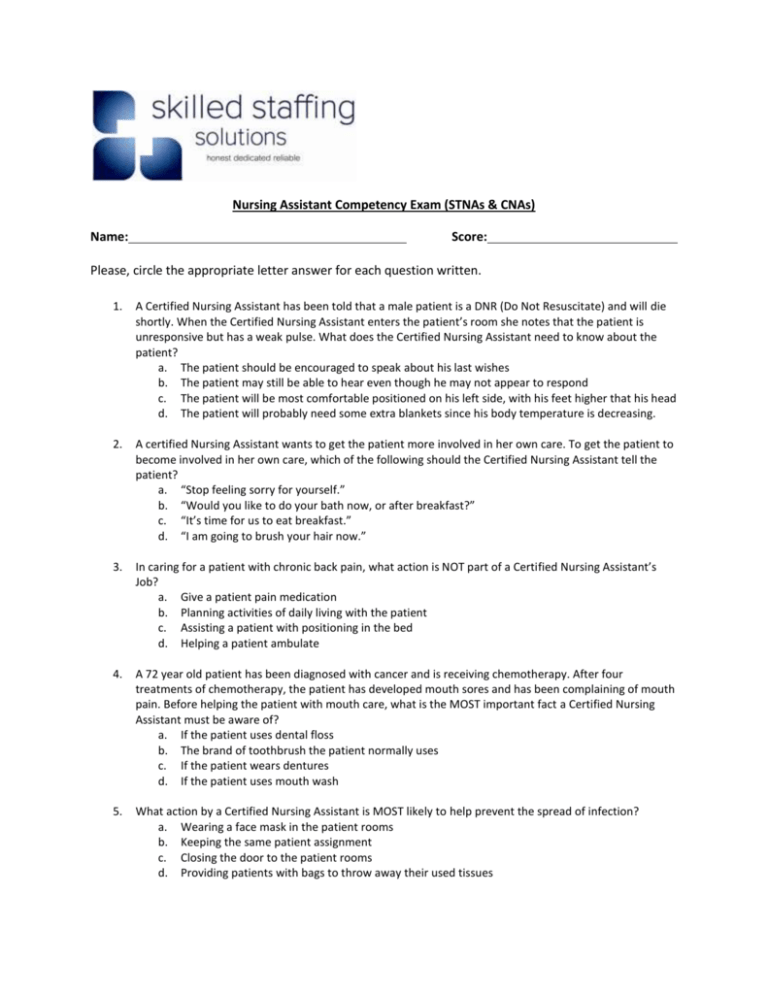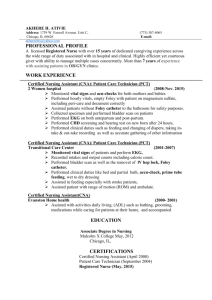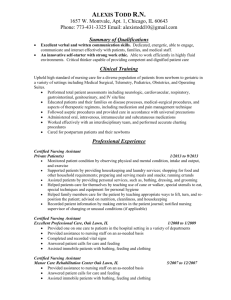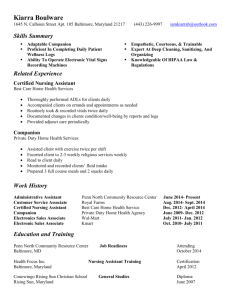Nursing Assistant Competency Exam
advertisement

Nursing Assistant Competency Exam (STNAs & CNAs) Name: Score: Please, circle the appropriate letter answer for each question written. 1. A Certified Nursing Assistant has been told that a male patient is a DNR (Do Not Resuscitate) and will die shortly. When the Certified Nursing Assistant enters the patient’s room she notes that the patient is unresponsive but has a weak pulse. What does the Certified Nursing Assistant need to know about the patient? a. The patient should be encouraged to speak about his last wishes b. The patient may still be able to hear even though he may not appear to respond c. The patient will be most comfortable positioned on his left side, with his feet higher that his head d. The patient will probably need some extra blankets since his body temperature is decreasing. 2. A certified Nursing Assistant wants to get the patient more involved in her own care. To get the patient to become involved in her own care, which of the following should the Certified Nursing Assistant tell the patient? a. “Stop feeling sorry for yourself.” b. “Would you like to do your bath now, or after breakfast?” c. “It’s time for us to eat breakfast.” d. “I am going to brush your hair now.” 3. In caring for a patient with chronic back pain, what action is NOT part of a Certified Nursing Assistant’s Job? a. Give a patient pain medication b. Planning activities of daily living with the patient c. Assisting a patient with positioning in the bed d. Helping a patient ambulate 4. A 72 year old patient has been diagnosed with cancer and is receiving chemotherapy. After four treatments of chemotherapy, the patient has developed mouth sores and has been complaining of mouth pain. Before helping the patient with mouth care, what is the MOST important fact a Certified Nursing Assistant must be aware of? a. If the patient uses dental floss b. The brand of toothbrush the patient normally uses c. If the patient wears dentures d. If the patient uses mouth wash 5. What action by a Certified Nursing Assistant is MOST likely to help prevent the spread of infection? a. Wearing a face mask in the patient rooms b. Keeping the same patient assignment c. Closing the door to the patient rooms d. Providing patients with bags to throw away their used tissues 6. How many milliliters are there in four and one third (4⅓ ounces? 30 milliliters equals one (1) ounce. a. 100 ml b. 130 ml c. 150 ml d. 180 ml 7. According to this clock, what time will it be in one-half hour? a. b. c. d. 10:38 10:08 10:04 10:00 8. When planning to give care to elderly patients who are alert and oriented, a Certified Nursing Assistant needs to remember that: a. Patients should take an active role in their care b. The wishes of family members are more important than the wishes of most patients c. The health care staff should decide what type of care is best for the patient without asking the patients d. Patients are responsible for the results of their treatments 9. An elderly patient who has a diagnosis of influenza has been admitted to a hospital unit. What personal protective equipment (PPE) should a Certified Nursing Assistant put on before entering the room to speak with the patient? a. Gloves only b. Mask, gown, and gloves c. Gown and gloves only d. Mask only 10. A Certified Nursing Assistant is feeding a patient a pureed diet. How should the Certified Nursing Assistant feed this patient? a. By asking the patient their preferences for eating b. By feeding all of one food at a time c. Any way the Certified Nursing Assistant wishes, since pureed food has no taste d. By mixing all of the food together to make feeding easier 11. Cold applications may cause injury to a patient if the patient has: a. A fever b. Dependent swelling c. Poor circulation d. Large bruises 12. How many milliliters are there in twelve and one-half (12 ½) ounces? 30 milliliters equals one (1) ounce. a. 350 ml b. 375 ml c. 400 ml d. 425 ml 13. An important function of the skin is to: a. Allow the body to move b. Help with gastric motility c. Promote exchange of gases within the body d. Protect the body from infection 14. A Certified Nursing Assistant is instructed to keep a record of a patient’s fluid intake. The patient leaves 2 ounces of juice in a 5 ounce cup. How many milliliters should be entered on the patient’s fluid intake record? (30ml = 1 ounce) a. 45 ml b. 75 ml c. 90 ml d. 150 ml 15. You are working as a Certified Nursing Assistant and a doctor you have never worked with before tells you to remove a Foley catheter from a patient. What should you do? a. Remove the Foley catheter b. Identify yourself as a CAN and ask the doctor to tell the nurse c. Tell the doctor to remove the catheter themselves d. Tell the doctor you refuse to remove the catheter 16. Mr. Marks says he is not getting any oxygen from his cannula into his nose. What should the Certified Nursing Assistant do FIRST? a. Turn the oxygen to 15 liters to test to see if it is working properly b. Turn the oxygen off c. Check the tubing connection to the oxygen tank d. Tell Mr. Marks to breathe faster to increase the amount of oxygen he is taking in 17. When you, as a Certified Nursing Assistant, are communicating with a 70-year-old patient, it is important that you: a. Speak softly, since the elderly often have hearing deficits b. Listen carefully to the patient c. Frequently interrupt the patient to get your point across d. Talk to the patient’s family members, as the patient is unlikely to comprehend the information 18. Mr. Johnson is a patient with memory problems who frequently loses his eyeglasses. He accuses a Certified Nursing Assistant of throwing them away. How should the CNA handle this situation? a. Acknowledge Mr. Johnson’s statement and help him find his glasses b. Encourage Mr. Johnson to apologize for his statement c. Remind Mr. Johnson that employees are not usually careless with patient property d. Tell Mr. Johnson he is wrong 19. What is the MOST common patient activity that results in falls? a. Putting on slippers b. Reaching for the telephone c. Getting up and going to the bathroom d. Ambulating in the hallway 20. You are working as a Certified Nursing Assistant who is assigned to assist a post-operative patient who has just returned to the surgical unit from the recovery room. Which of the following should you report IMMEDIATELY to the nurse who is taking care of the patient? a. The patient is complaining of pain b. The patient has a systolic blood pressure drop of 5mmHg from her post-op pressure of 120/80 c. The patient’s skin is pink and slightly warm to the touch d. The patient’s intravenous solution is dripping regularly into the intravenous line 21. 30 milliliters equals one (1) ounce. A patient is given five (5) ounces of juice and the patient drinks all of it. How many milliliters did the patient drink? a. 150 ml b. 200 ml c. 250 ml d. 300 ml 22. What procedure would be INCORRECT for a Certified Nursing Assistant to perform when providing foot care to a patient? a. Placing small pieces of gauze between the patient’s toes b. Cutting the patient’s toenails c. Encouraging the patient to wear socks with shoes d. Checking the patient’s feet for reddened areas 23. If the Certified Nursing Assistant needs to wear a gown in an isolation room, what should the SNA assistant do with that gown? a. Keep that same gown for use in all isolation rooms b. Leave the gown untied so it can be easily removed later c. Take the gown off in a utility room away from the patients room d. Remove the gown before exiting the patients room and throw it away 24. A female Certified Nursing Assistant is assigned by a nurse to take a blood sugar reading of a new patient. When the CAN meets this new patient for the first time, the CAN should: a. Ask the patient if he has diabetes b. Put on gloves c. Check the patient’s diet d. Introduce herself to the patient 25. A patient has an indwelling catheter connected to a drainage bag. For this patient the drainage bag should be: a. Below the level of his bladder b. At the level of his bladder c. At the level of his kidneys d. Above the level of his kidneys 26. A Certified Nursing Assistant is assisting a patient with a high risk of fall, who is using the commode. The CNA receives another page to go to another patient’s room. What should the CNA do? a. Tell the patient they will be right back and leave the room in response to the page b. Make sure the patient using the commode has the call bell within reach before leaving the room c. Stay with the patient who is using the commode and ignore the page d. Contact the person paging and say they are unable to respond at this time 27. Which of the following foods can be introduced on a clear liquid died a. Skim milk b. Strained orange juice c. Jell-O d. Vanilla ice cream 28. A Certified Nursing Assistant is helping a post-op patient with a bed bath. The patient prefers to wash her own genital and rectal areas herself. What information should the CNA tell the patient? a. To wash from the vaginal area toward the rectal area b. To avoid using soap when washing her rectal area c. To use only cold water to wash her vaginal area d. To wash only the outside of her labia 29. A Certified Nursing Assistant has been assigned to take a patient’s radial pulse. The radial pulse is located on what site of the human body? a. Wrist b. Groin c. Chest d. Ankle 30. You are working as a Certified Nursing Assistant and an 89-year-old patient you are caring for is receiving a blood transfusion. When you enter the patient’s room, the patient complains of feeling chills. You, as the CAN should: a. Get warm blankets for the patient b. Check the thermostat and turn the heat up c. Immediately notify the nurse caring for the patient d. Clamp the blood 31. A certified Nursing Assistant offers the patient 10 ounces of water. The patient drinks 180 ml of the water. How much of the water is left? (30ml = 1 ounce) a. 30 ml b. 60 ml c. 90 ml d. 120 ml 32. In order to follow Standard/Universal Precautions, a Certified Nursing Assistant should: a. Wear a mask when collecting a capillary blood sample b. Wash hands before putting on gloves and after removing them c. Double bag all linen before removing it from a patient’s room d. Dispose of all of the patient’s eating utensils in the patient’s wastebasket 33. 30 milliliters equals one (1) ounce. A patient is given ten (10) ounces of juice and the patient drinks one quarter of that juice. How much juice did the patient drink? a. 75 ml b. 100 ml c. 125 ml d. 150 ml Applicant Signature: Date:






